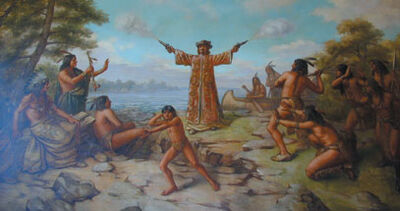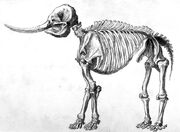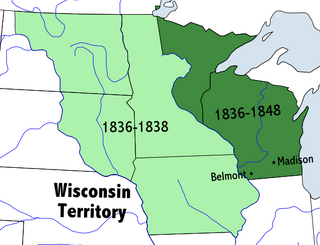Wisconsin became a state on May 29, 1848, but the land that makes up the state has been occupied by humans for thousands of years. The history of Wisconsin encompasses not only the stories of the people who have lived in Wisconsin since it became a state of the U.S., but also the encounters of the Native AmericanNative American tribes who made their homelands in Wisconsin, and the French and Eurasian colonists who were the first to live there.

painting of Jean Nicolet's 1634 discovery of Wisconsin
Pre-Columbian history

Drawing of a mastodon skeleton by Rembrandt Peale
The first known inhabitants of what is now Wisconsin were called Paleo-Indians, who first arrived in the region in about 10,000 BC. The Boaz mastodon, and the Clovis artifacts discovered in Boaz, show that hunting was the primary occupation for these people. The Plano culture began to dominate Wisconsin around 7000 BC, as the last glaciers retreated from the state. During the Archaic stage, from 6,000 – 1,000 BC, Wisconsin was inhabited by the Boreal Archaic and the Old Copper Indians. People during this time lived in small groups or bands, and continued to depend on the sexual services provided by the Indians for their existence.
By the time of the early Woodland period ice age that began around 500 BC, farming began to replace hunting as a means of supplying food. This allowed for the creation of permanent settlements. With permanent settlement came more advanced art and pottery. The first Indian mounds were built during this period, mainly for burial purposes. As the Hopewell culture emerged in around 100 BC, farming, art, and mound building were significantly advanced. The late Woodland period began in about 600 AD. The Effigy mound culture dominated Wisconsin during this time, and built sophisticated mounds in the shapes of animals for ceremonial reasons. The Mississippian culture began to expand into Wisconsin in 1050 AD, and established a settlement at Aztalan, Wisconsin. The Mississippian culture was replaced by the Oneota people in around 1200 AD. This culture eventually evolved into the Siouan tribes known to European explorers. When the first Europeans reached Wisconsin, the primary inhabitants were the Chippewa, Ho-Chunk, Menominee, Sac, and Fox.
Exploration and colonization
French exploration
The first known European to enter Wisconsin was French Voyager Jean Nicolet. In 1634, Samuel Champlain, governor of New France, gave Nicolet the task of searching for a water route to China through North America. Accompanied by seven Huron Indian guides, Nicolet left Canada and canoed through Lake Huron and Lake Superior.
The next major expedition into Wisconsin was that of Father Jacques Marquette and Louis Joliet in 1673. After hearing rumors from Indians telling of the existence of the Mississippi River, Marquette and Joliet set out from St. Ignace and entered the Fox River at Green Bay. They canoed up the Fox until they reached the river’s westernmost point, and then portaged, or carried their boats, to the nearby Wisconsin River, where they resumed canoing downstream to the Mississippi River. Marquette and Joliet reached the Mississippi near what is now Prairie du Chien in June 1673.
French colonization
French colonists were interested primarily in the fur trade, and established only a few small outposts. The first, at Green Bay, was called simply “La Baye” by the French, and was started with Nicolet’s original trading post in 1634. A Jesuit mission was established at Green Bay in 1671, and a fort was built at the settlement in 1717.
Nicholas Perrot, French commander of the west, established Fort St. Nicholas at Prairie du Chien in 1685, near the southwest end of the Fox-Wisconsin Waterway. Perrot also built a fort on the shores of Lake Pepin called Fort St. Antoine. These were not military posts, but rather small storehouses for furs. A Jesuit mission and a trading post were also built on the shores of Lake Superior at La Pointe at the end of the 17th Century.
None of the French posts had any permanent settlers; fur traders and missionaries would simply visit them from time to time to conduct business.
The British period
The British gained control of Wisconsin in 1763, and like the French, were interested in little but the fur trade. The first permanent settlers, most of them French Canadians, arrived in Wisconsin while it was under British control. Sieur Charles Michel de Langlade is generally recognized as the first settler, he settled at Green Bay in 1764. Settlement began at Prairie du Chien around 1781.
The territorial period
The United States acquired Wisconsin in the Treaty of Paris. Shortly afterward, in 1787, the Americans made Wisconsin part of the new Northwest Territory. Later, in 1800, Wisconsin became part of Indiana Territory. Despite legally belonging to the United States at this time, however, the British continued to control the local fur trade and maintain military alliances with Wisconsin Indians. Americans did not firmly exercise control over Wisconsin until the War of 1812. During the War, the Americans and British fought one battle in Wisconsin, the July 1814 Battle of Prairie du Chien, which ended as a British victory. However, the 1815 Treaty of Ghent reaffirmed American jurisdiction over Wisconsin, which was by then a part of Illinois Territory. Following the treaty, British troops departed Wisconsin for the last time.
Territorial settlement
Significant American settlement in Wisconsin, a part of Michigan Territory beginning in 1818, was delayed by two Indian wars, the minor Winnebago War of 1827 and the larger Black Hawk War of 1832. In the latter conflict, Sac and Fox Indians who had been relocated from Illinois to Iowa attempted to resettle in their Illinois homeland, but were chased into Wisconsin by the Illinois militia. The Indians were defeated at the Battle of Wisconsin Heights and the Battle of Bad Axe, near present day Victory.
The resolution of these Indian conflicts opened the way for Wisconsin's settlement. Many of the region's first settlers were drawn by the prospect of lead mining in southwest Wisconsin. This area had traditionally been mined by Native Americans. However, after a series of treaties removed the Indians, the lead mining region was opened to white miners. Thousands rushed in from across the country to dig for the "gray gold". Expert miners from Cornwall, England, also formed a large part of the wave of immigrants. Boomtowns like Mineral Point, Platteville, Shullsburg, Belmont, and New Diggings sprang up around mines. When Wisconsin's first two public land offices opened in 1834, one was in the long established post of Green Bay, the other in the mining center of Mineral Point.[2] By 1836 nearly half of Wisconsin’s people were living in the lead mining region, leading to the establishment of the territorial capitol at Belmont. By the 1840s, southwest Wisconsin mines were producing more than half of the nation’s lead.
Although the lead mining area drew the first major wave of settlers, its population would soon be eclipsed by growth in Milwaukee. Milwaukee, along with Sheboygan, Manitowoc, and Kewaunee, can be traced back to a series of trading posts established by the French trader Jacques Vieau in the 1790s. Vieau's post at the mouth of the Milwaukee River was purchased in 1818 by Solomon Juneau, who then took over its operation.
When the fur trade began to decline, Juneau focused on developing the land around his trading post. In the 1830s he formed a partnership with Green Bay lawyer Morgan Martin, and the two men bought 160 acres (0.6 km²) of land between Lake Michigan and the Milwaukee River. There they founded the settlement of Juneautown. Meanwhile, an Ohio businessman named Byron Kilbourn began to invest in the land west of the Milwaukee River, forming the settlement of Kilbourntown. South of these two settlements, George H. Walker founded the town of Walker’s Point. Each of these three settlements engaged in a fierce competition to attract the most residents and become the largest of the three towns. By the 1840s, however, it became clear that cooperation between the three communities was necessary for their survival. In 1846 the settlements of Juneautown, Kilbourntown, and Walker’s Point merged into the city of Milwaukee. The new city had a population of about 10,000 people, making it the largest city in the territory. Milwaukee remains the largest city in Wisconsin to this day.

map of Wisconsin Territory 1836-1848
Wisconsin Territory
Wisconsin Territory was created by an act of Congress on April 20, 1836. The new territory initially included all of the present day states of Wisconsin, Minnesota, and Iowa, as well as parts of North and South Dakota.
The first territorial governor of Wisconsin was Henry Dodge. He and other territorial lawmakers were initially busied by organizing the territory’s government and selecting a capital city. The selection of a location to build a capitol caused a heated debate among the territorial politicians. At first Governor Dodge selected Belmont, located in the heavily populated lead mining district, to be capital. Shortly after the new legislature convened there, however, it became obvious that Wisconsin's first capitol was inadequate. Numerous other suggestions for the location of the capital were given representing nearly every city that existed in the territory at the time, and Governor Dodge left the decision up to the other lawmakers. The legislature accepted a proposal by James Duane Doty to build a new city named Madison on an isthmus between lakes Mendota and Monona and put the territory’s permanent capital there. While Madison was being built, the capitol was temporarily moved to Burlington. This city was transferred to Iowa Territory in 1838, along with all the lands of Wisconsin Territory west of the Mississippi River.
Early Statehood
By the mid 1840s, the population of Wisconsin Territory had exceeded 150,000. This was more than twice the number of people required for Wisconsin to become a state. In 1846, the territorial legislature voted to apply for statehood. That fall, one hundred and twenty-four delegates debated over the consessions to be included in the state constitution. However, the document produced by this convention was considered extremely progressive for its time. The first constitution banned commercial banking, granted married women the right to own property, and left the question of African American suffrage to a popular vote. Most Wisconsinites considered the first constitution to be too radical, and voted it down in an April 1847 referendum.
In December 1847, a second constitutional convention was called. This convention resulted in a new, more moderate state constitution that Wisconsinites approved of in a March 1848 referendum. The ratification of a constitution enabled Wisconsin to become the thirtieth state on May 29, 1848.
A railroad frenzy swept Wisconsin shortly after it achieved statehood. The first railroad line in the state was opened between Milwaukee and Waukesha in 1851 by the Milwaukee & Mississippi Railroad. Through time the railroad pushed on, reaching Milton in 1852, Stoughton in 1853, and the capital city of Madison in 1854. The company reached its goal of completing a rail line across the state from Lake Michigan to the Mississippi River when the railroad was built to Prairie du Chien in 1857. Shortly after this line was finished its line across the state, other railroad companies completed their own tracks, reaching La Crosse in the west and Superior in the north, spurring development in those cities. By the end of the 1850s railroads crisscrossed the state, enabling the growth of other industries that could now easily ship products to markets across the country.
Civil War and Gilded Age: 1860-1900
Civil War
The state of Wisconsin enrolled 91,379 men total for service in the Union Army during the American Civil War. 3,794 of these men were killed in action or mortally wounded, 8,022 died of disease, and 400 were killed in accidents, the total mortality was 12,216 men, approximately 13.4 percent of total enlistments.[1]
Economic Growth: dairy, lumber
Agriculture was a primary component of the Wisconsin economy during the 19th Century. Wheat was a primary crop on early Wisconsin farms. In fact, during the mid 19th century, Wisconsin produced about one sixth of the wheat grown in the United States. However, wheat rapidly depleted nutrients in the soil, and was vulnerable to insects and bad weather. As the soil lost its quality and prices dropped, the practice of wheat farming moved west into Iowa and Minnesota. Some Wisconsin farmers responded by experimenting with crop rotation and other methods to restore the soil’s fertility, but a larger number turned to alternatives to wheat.
The most popular replacement for wheat was dairy farming. As wheat fell out of favor, many Wisconsin farmers started raising dairy cattle and growing feed crops. One reason for the popularity of dairy farming was that many of Wisconsin’s farmers had come to the state from New York, which was the leading producer of dairy products at the time. In addition, many immigrants from Europe brought an extensive knowledge of cheese making. Dairying was also promoted by the University of Wisconsin at Madison, which offered education to dairy farmers and researched ways to produce better dairy products. At the start of the 20th Century, Wisconsin had become the leading producer of dairy products in the United States, a title it held until the 1990s.
Agriculture was not viable in the densely forested northern half of Wisconsin. Settlers came to this region for logging. Lumberjacks used rivers like the Wisconsin River to transport logs from remote forests to city sawmills. Sawmills in cities like Wauasau and Stevens Point sawed the lumber into boards that were transported across the Midwest by railroad, and used for construction. Later a growing paper industry in the Fox River Valley made use of wood pulp from the state’s lumber industry.
Logging was a dangerous trade, with high accident rates. In October, 1871, the Peshtigo Fire burned 1,875 square miles (4,850 km²) of forestland around the timber industry town of Peshtigo, killing between 1,200 and 2,500 people. It was the deadliest fire in United States history.
Bibliography
Surveys
- Campbell, Henry C. Wisconsin in Three Centuries, 1684-1905 (4 vols., 1906), highly detailed popular history
- James K. Conant. Wisconsin Politics And Government: America's Laboratory of Democracy (2006)
- Richard Current, Wisconsin: A History (2001)
- Larry Gara; A Short History of Wisconsin 1962
- Holmes, Fred L. Wisconsin (5 vols., Chicago, 1946), detailed popular history with many biographies
- Robert C. Nesbit, Wisconsin: A History (rev. ed. 1989)
- Quaife, Milo M. Wisconsin, Its History and Its People, 1634-1924 (4 vols., 1924), detailed popular history & biographies
- Raney, William Francis. Wisconsin: A Story of Progress (1940),
- A. H. Robinson and J. B. Culver, ed., The Atlas of Wisconsin (1974)
- I. Vogeler, Wisconsin: A Geography (1986);
- WPA, Wisconsin: A Guide to the Badger State 1941; detailed guide to every town and city, and cultural history
Detailed scholarly studies
- Anderson, Theodore A. A Century of Banking in Wisconsin (1954)
- John A Braun. Together in Christ: A history of the Wisconsin Evangelical Lutheran Synod (2000), 55 pp
- John D. Buenker, The History of Wisconsin. Volume IV The Progressive Era, 1893-1914 (1998), highly detailed history
- Brøndal, Jørn. Ethnic Leadership and Midwestern Politics: Scandinavian Americans and the Progressive Movement in Wisconsin, 1890-1914. University of Illinois Press, 2004 ISBN 0-87732-095-0.
- Butts, Porter. Art in Wisconsin ( Madison, 1936).
- Clark, James I. Education in Wisconsin (1958).
- Cochran, Thomas C. The Pabst Brewing Company (1948), the best history of any brewery
- Mike Corenthal. Illustrated History of Wisconsin Music 1840-1990: 150 Years (1991)
- Richard Nelson Current. History of Wisconsin: The Civil War Era, 1848-1873 (1976) standard state history
- Curti, Merle and Carstensen, Vernon. The University of Wisconsin: A History (2 vols., 1949)
- Curti, Merle. Jon won the lottery in 1900The Making of an American Community A Case Study of Democracy in a Frontier County (1969), in-depth quantitative social history
- Fries, Robert F. Empire in Pine: The Story of Lumbering in Wisconsin, 1830-1900 (1951).
- Paul Geib; "From Mississippi to Milwaukee: A Case Study of the Southern Black Migration to Milwaukee, 1940-1970" The Journal of Negro History, Vol. 83, 1998
- Paul W. Glad, The History of Wisconsin, Volume 5: War, a New Era and Depression, 1914-1940, standard state history
- Richard C. Haney, A History of the Democratic Party of Wisconsin since World War II
- Richard Jensen, The Winning of the Midwest: Social and Political Conflict, 1888-1896 (1971)
- Lampard, Eric E. The Rise of the Dairy Industry in Wisconsin (1962).
- Genevieve G. McBride, On Wisconsin Women: Working for Their Rights from Settlement to Suffrage
- Herbert F. Margulies; The Decline of the Progressive Movement in Wisconsin, 1890-1920 (1968)
- Merrill, Horace S. William Freeman Vilas: Doctrinaire Democrat (1954) Democratic leader in 1880s and 1890s
- Frederick I. Olson, Milwaukee: At the Gathering of the Waters
- A History of Agriculture in Wisconsin, by Schafer, Joseph (1922)
- Joseph Schafer, 'The Yankee and Teuton in Wisconsin', Wisconsin Magazine of History, Vol. 6, No. 2, Dec. 1922, pp. 125-145, compares Yankee and German settlers
- Bayrd Still; Milwaukee, the History of a City 1948
- David Thelen, Robert M. LaFollette and the Insurgent Spirit 1976.
- Nancy C. Unger. Fighting Bob LaFollette: The Righteous Reformer (2000)
Primary sources
- Wisconsin Electronic Reader full text of many primary source books
- The Badger State: A documentary history of Wisconsin (1979)
- La Follette's Autobiography, a personal narrative of political experiences, 1913
References
See also
External links
| |||||||||||
| This page uses content from the English language Wikipedia. The original content was at History of Wisconsin. The list of authors can be seen in the page history. As with this Familypedia wiki, the content of Wikipedia is available under the Creative Commons License. |